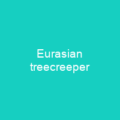The Eurasian nuthatch is a small passerine bird found throughout the Palearctic and in Europe. It is a short-tailed bird with a long bill, blue-grey upperparts and a black eye-stripe. There are more than 20 subspecies in three main groups.
About Eurasian nuthatch in brief
 The Eurasian nuthatch is a small passerine bird found throughout the Palearctic and in Europe. It is a short-tailed bird with a long bill, blue-grey upperparts and a black eye-stripe. There are more than 20 subspecies in three main groups. Its preferred habitat is mature deciduous or mixed woodland with large, old trees, preferably oak. Pairs hold permanent territories, and nest in tree holes, usually old woodpecker nests, but sometimes natural cavities. The 6–9 red-speckled white eggs are laid on a deep base of pine or other wood chips. Its main natural predator is the Eurasian sparrowhawk. It has a large population and huge breeding area, and is therefore classified by the International Union for Conservation of Nature as being of least concern. The adult male of the nominate subspecies, S. e.europaea is 14 cm long with a 22. 5–27 cm wingspan. It weighs 17–28 g. It has blue- grey upperparts, a black- Stripe and whitish underparts. The flanks and lower belly are orange-red with white on the undertail. The stout bill is dark grey with a paler area on the lower mandible, the iris is dark brown and the legs are pale or brown or brown. Most other members of the Sitta e. europaea group differ in detail from the nominate form, but often with respect to the hue of the underparts, but S. arctica is quite distinctive, with a white forehead and reduced eye-strippe, and it has more white in the tail and wings than any other subspecies.
The Eurasian nuthatch is a small passerine bird found throughout the Palearctic and in Europe. It is a short-tailed bird with a long bill, blue-grey upperparts and a black eye-stripe. There are more than 20 subspecies in three main groups. Its preferred habitat is mature deciduous or mixed woodland with large, old trees, preferably oak. Pairs hold permanent territories, and nest in tree holes, usually old woodpecker nests, but sometimes natural cavities. The 6–9 red-speckled white eggs are laid on a deep base of pine or other wood chips. Its main natural predator is the Eurasian sparrowhawk. It has a large population and huge breeding area, and is therefore classified by the International Union for Conservation of Nature as being of least concern. The adult male of the nominate subspecies, S. e.europaea is 14 cm long with a 22. 5–27 cm wingspan. It weighs 17–28 g. It has blue- grey upperparts, a black- Stripe and whitish underparts. The flanks and lower belly are orange-red with white on the undertail. The stout bill is dark grey with a paler area on the lower mandible, the iris is dark brown and the legs are pale or brown or brown. Most other members of the Sitta e. europaea group differ in detail from the nominate form, but often with respect to the hue of the underparts, but S. arctica is quite distinctive, with a white forehead and reduced eye-strippe, and it has more white in the tail and wings than any other subspecies.
Nuthatches are a family of similar-looking birds with short tails and wings, compact bodies and longish pointed bills. All are in the single genus Sitta and form a superspecies with the chestnut-vented, Indian, chestnuts-bellied and Kashmir nuthatches and has in the past been considered conspecific with all of these. The fossil record for nuthatching is sparse, and in. Europe is limited to the extinct Sitta senogalliensis from the Lower Miocene in Italy and somewhat later material from France; the family appears to be of relatively recent origin. It readily visits bird tables, eating fatty man-made food items as well as seeds. It is an inveterate hoarder, storing food year-round. The species’ range is still expanding, but the species’ population is still growing. It can forage when descending trees head first, aswell as when climbing, and often eats seeds, food items mainly being found on tree trunks and large branches. The bird is quite large, quite distinctive in appearance and genetically, and may be another subspecies group or even a separate species. The large, white-breasted S. e.arctica of north east Siberia is distinctive.
You want to know more about Eurasian nuthatch?
This page is based on the article Eurasian nuthatch published in Wikipedia (as of Nov. 06, 2020) and was automatically summarized using artificial intelligence.







